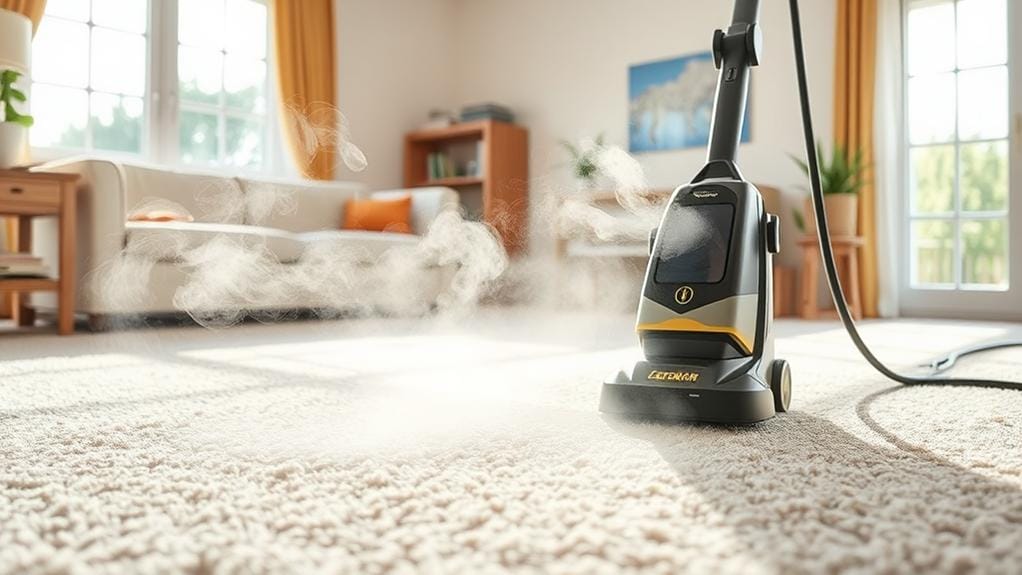If you're a Chester Hill homeowner, maintaining your carpet can save you time and money in the long run. You might be surprised at how simple it is to address common issues like stains, tears, or loose areas. Before you grab a cleaner or scissors, guaranteeing that you assess the damage and gather the right tools is crucial. With the right approach, you can tackle problems effectively and restore your carpet's appearance. But what steps should you take first to make certain a successful repair? Let's explore some essential tips that can make a real difference.
Assessing Carpet Damage
When it comes to evaluating carpet damage, a thorough assessment can save you time and money. Start by examining the affected area closely. Look for stains, tears, or fraying edges. Identify the type of damage—whether it's surface-level, like a stain, or more serious, like a rip that goes through the fibers. It's also crucial to take into account the benefits of professional carpet cleaning, as experts use the latest techniques to restore carpets effectively and can help with carpet cleaning services.
Next, pay attention to the size of the damage. Small stains might only require spot cleaning, while larger tears may need patching or even replacement sections. Don't forget to check the surrounding areas too. Often, damage can spread or affect nearby sections, so it's wise to review more than just the immediate problem.
Also, account for the carpet material and its age. Older carpets could be more fragile, making them harder to repair. If you spot any mold or odors, that's a sign of deeper issues needing immediate attention.
Gathering Necessary Tools
After evaluating the damage to your carpet, it's time to gather the necessary tools for repairs. Start by collecting a sharp utility knife. This will help you cut the carpet and padding cleanly without fraying the edges. If you're unsure about the right cleaning techniques, consider reaching out to professionals who offer trustworthy carpet cleaning services in Auburn.
Next, grab a measuring tape to guarantee you get the right dimensions for any patches you need to cut.
You'll also need carpet adhesive or double-sided tape, depending on the repair type. If you're dealing with a small area, a carpet seam roller can help secure the edges and create a seamless finish. Don't forget a pair of scissors for trimming any excess carpet fibers or padding.
A pair of pliers is useful for pulling up any stubborn carpet sections, while a vacuum cleaner can help clean the area before you begin. If you're working with a carpet patch, having a carpet patch kit on hand will save you time. Finally, consider wearing knee pads. They'll make kneeling more comfortable as you work.
With these tools gathered, you'll be well-equipped to tackle your carpet repair effectively. Now, you're ready to move on to the next steps in restoring your carpet to its former glory.
Tackling Stains Quickly
Acting quickly is essential when it comes to tackling stains on your carpet. The longer a stain sits, the harder it becomes to remove. As soon as you notice a spill, grab some paper towels or a clean cloth to blot the area. Don't rub; that can spread the stain or push it deeper into the fibers. For those in Chester Hill, it's also beneficial to know that trusted carpet cleaning services can offer expert advice and assistance when needed.
Next, determine the type of stain you're dealing with. For water-based stains like juice or coffee, a mix of mild dish soap and warm water can work wonders. Apply the solution to the stained area, then blot with a clean cloth until the stain lifts. Remember to rinse the area with plain water afterward to remove any soap residue.
For oil-based stains, you might need a specialized cleaner. Always test any product on a hidden area first to avoid damaging your carpet. If the stain persists, don't hesitate to consult a professional cleaner—some stains are tricky and require expert attention.
Keeping your carpet clean isn't just about aesthetics; it prolongs its life, too. So, stay vigilant and act fast when accidents happen!
Repairing Small Tears
Even with the best efforts to keep your carpet clean, accidents can lead to small tears that need attention. Fortunately, repairing these minor issues can be straightforward if you know the right steps.
- Assess the Damage: First, examine the tear closely. If it's just a small rip and the fibers aren't fraying too much, you can likely fix it yourself.
- Gather Your Supplies: You'll need a pair of scissors, carpet adhesive, a small brush, and a piece of matching carpet (if available). If you don't have a spare piece, you can often cut from an inconspicuous area.
- Apply Adhesive: Lift the torn edges and apply a thin layer of carpet adhesive underneath. Press the fibers back together, ensuring they align properly. If you have extra carpet, cut a piece to fit the tear and glue it in place.
Once you've completed these steps, allow the adhesive to cure as per the manufacturer's instructions. Regular maintenance and quick repairs will help keep your carpet looking its best!
Dealing With Burn Marks
Burn marks on your carpet can be frustrating, but don't worry—there are effective ways to address them. First, assess the damage. If the burn is shallow, you might be able to fix it without much hassle. Start by trimming away any singed fibers with sharp scissors, being careful not to cut the surrounding carpet.
Next, you can try a simple DIY method using a mixture of baking soda and water. Create a paste and gently rub it into the burn mark using a soft cloth. Let it sit for about 30 minutes, then vacuum the area to lift away any residue.
If the burn mark is deeper, you may need to use a carpet repair kit, which often includes adhesive and replacement fibers. Follow the instructions carefully, ensuring you match the carpet color as closely as possible.
Lastly, if you're unsure or the damage is extensive, consider calling a professional. They've the expertise to restore your carpet without causing further harm. With these steps, you can successfully tackle those burn marks and keep your carpet looking great!
Replacing Damaged Sections
Carpet damage can be a real eyesore, but replacing damaged sections can restore your flooring's appearance and functionality. If you've noticed frayed edges, stains, or tears, it's time to take action.
Identify the Damage: Start by evaluating the extent of the damage. If the area is small and localized, a patch may suffice. For larger areas, consider replacing a whole section.
Gather Materials: You'll need a carpet patch, adhesive, a utility knife, and a carpet seam roller. Make sure your patch matches the existing carpet in both texture and color for a seamless look.
Cut and Secure the Patch: Use the utility knife to cut away the damaged section. Next, cut your patch slightly larger than the hole and trim it down for a perfect fit. Apply adhesive and press down firmly, then use the seam roller to secure the edges.
Stretching Loose Carpet
A loose carpet can greatly detract from your home's comfort and appearance. If you're dealing with wrinkles or bumps, stretching the carpet is often the best solution. You'll need a few tools: a knee kicker, a carpet stretcher, and some carpet tape.
First, remove any furniture from the area to give yourself plenty of space. Next, use the knee kicker to push the carpet toward the wall, making sure to start at one corner. This tool will help you pull the carpet taut without damaging it.
Once you've got the carpet nice and tight, use the carpet stretcher to secure it in place. Position the stretcher against the wall and push down on the lever to stretch the carpet further. Make sure the carpet lies flat, and check for any remaining wrinkles.
Cleaning Pet Accidents
After you've tackled loose carpet issues, you might find yourself facing the challenge of cleaning pet accidents. Don't worry; with the right approach, you can restore your carpet's freshness.
- Act Quickly: As soon as you notice the accident, blot the area with a clean cloth or paper towel to absorb as much liquid as possible. Avoid rubbing, as this can spread the stain.
- Use an Appropriate Cleaner: Once you've blotted the area, apply a pet-safe enzyme cleaner. These cleaners break down the odor-causing substances, making it easier to remove stains. Follow the instructions on the label for the best results.
- Rinse and Dry: After applying the cleaner, rinse the area with cold water and blot again to remove any residue. Once it's clean, let the area air dry completely. If needed, you can place a fan nearby to speed up the drying process.
Preventing Future Damage
To keep your carpet looking great and minimize future damage, it is vital to implement some preventive measures. First, consider placing mats at entrances to trap dirt and moisture before it reaches your carpet. Regular vacuuming is essential, too, as it removes debris that can wear down fibers over time.
Next, be mindful of how you arrange your furniture. Avoid placing heavy items on your carpet for extended periods, as this can cause indentations. To help with this, you can rotate your furniture occasionally.
Finally, address spills immediately to prevent stains from setting in. Here's a quick reference table to help you remember these tips:
| Preventive Measure | Frequency | Purpose |
|---|---|---|
| Use mats at entrances | Always | Traps dirt and moisture |
| Regular vacuuming | Weekly | Removes debris |
| Rotate furniture | Every 6 months | Prevents indentations |
| Immediate spill cleanup | As needed | Prevents stains |
When to Call a Professional
When should you call a professional for carpet repair? It's crucial to know your limits when tackling carpet issues. While some repairs can be handled at home, others require expert intervention.
- Extensive Damage: If your carpet has significant tears, burns, or stains that won't come out, it's best to consult a pro. They've the tools and skills to fix serious issues effectively.
- Subfloor Problems: If you notice sagging or uneven areas in your carpet, it might indicate a subfloor issue. Professionals can assess the situation and provide the right solutions, ensuring your carpet is stable and safe.
- Time Constraints: If you're pressed for time or lack the necessary tools, hiring a professional can save you from frustration. They can complete repairs quickly and efficiently, allowing you to focus on other responsibilities.
In short, don't hesitate to call a professional when you're faced with extensive damage, subfloor issues, or time constraints. Their expertise can save you time, effort, and ultimately, money.
Conclusion
By following these tips, you can keep your carpet in top shape and extend its life. Regular maintenance, quick stain responses, and timely repairs make a significant difference. Remember, it's always best to consult a professional for more complex issues. With these strategies in your toolkit, you'll not only enhance your home's appearance but also enjoy a clean and comfortable living space for years to come. Don't wait—start tackling those carpet issues today!



